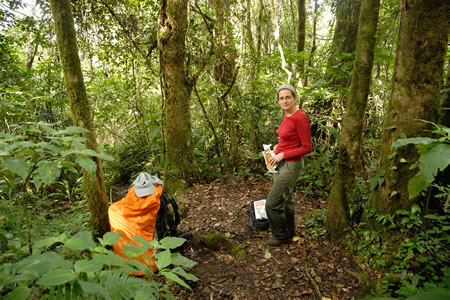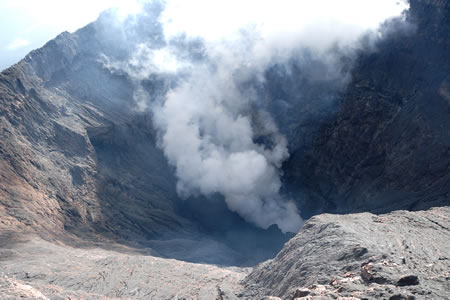

| Gunung Kerinci: clambering to the top | |
Bangko (Indonesia), July 5th 2008 |
|
With sleepy eyes we are taking our breakfast at 05:30 in the morning. A pancake with banana and chocolate must give us the necessary energy to walk the first kilometres on the way to the top of Gunung Kerinci. Gunung Kerinci has an altitude of 3805 metres and is the largest volcano of the Indonesian island Sumatra. The volcano stands in the largest national park of Sumatra, which is the home of many animals including the Sumatran Tiger and Rhino. We don’t have high expectations of crossing paths with those illustrious inhabitants of the park, because they rarely show themselves. When we see some nice birds and when we are able to have a peek into the crater of the volcano we are satisfied. At 6:00 a.m. we start our walk. The first five kilometres take us on a paved road through the tea plantations to the entrance of the national park. This is a nice warm up, but not representative for the journey to come. Today, we want to reach the camping ground on an altitude of 3200 metres and we start on an altitude of 1500 metres. So, our legs have a considerable climb ahead. Edwin will have to carry not only himself to this altitude but also a big backpack with among others a tent, sleeping bags and sleeping mattresses. Ivonne is carrying a daypack the bottles of drinking water, food and the photo equipment. Usually we take a porter with us on overnight trekkings, to carry the big backpack and to act as guide and cook. The way to the top of Gunung Kerinci, however, is easy to find and therefore we want to try it on our own this time. |
|
 |
|
Taking a break during the climb of Mt. Kerinci |
|
As soon as we enter the park, we are surrounded by the song of birds. Kerinci National Park is an important place of residence of Sumatra’s endemic birds, so it is not surprisingly that this park is frequently visited by birders. One of the target birds on the lists of birders is the Salvadori’s Pheasant. On first sight, the female of this bird has many similarities with a brown chicken and we almost step on such a female because she sits on the path where we find our way up. The first part of the path is easy, but it gets more difficult when we get higher. Some parts we have to walk under low hanging vegetation and Edwin sometimes gets stuck under the vegetation with his big backpack. But when we hear some tree branches breaking we don’t have time to feel tired. When we look up, we see a beautiful Siamang. This black gibbon is truly a gifted acrobat and we have a great time watching him swinging from tree to tree. When the gibbon is out of sight we proceed our way on the slippery paths. Some parts of the paths are through very narrow slots through slippery rocks. Fortunately, the weather is still fine. When it rains, these paths will be even more slippery. When we reach an altitude of 2700 metre, we start to feel our legs. The scrambling starts taking its toll and, even worse, the sky is clouded over. Luckily, it stays dry until we reach the camping ground at 3200 metres. We pitch the tent that we hired from the guesthouse. Because some other trekkers warned us that the tent isn’t fully waterproof, we put an additional sheet of plastic on the tent which we attach with strings and rocks. From small pieces of wood, we make tent pegs and after half an hour we are finally ready to open the lunch packages that the guesthouse prepared for us. Because we are in Indonesia, this means that we have to eat rice. This time it is cold white rice with a skinny chicken chop, a fried egg, two slices of cucumber and some strong sambal. At a small campfire we dry our clothes that have become wet due to the muddy paths and the wet vegetation. We are kept company by a group of small birds that have it in for the spilled over grains of rice. Around 6 p.m. we are forced into the tent by the rain. From the inside, the tent seems even smaller then from the outside. Even Ivonne can’t stretch herself while she is only 1.63 metres. So, you don’t have to have a lot of imagination to visualize how Edwin has to curl himself up to fit in the tent. There is a cloudburst and a thunderstorm right above our too little tent. This in combination with the too thin sleeping mattresses causes for a sleepless night. |
|
 |
|
A view in the crater of the Kerinci volcano |
|
| The next morning we get up at 05:30 to prepare ourselves for the long walking day ahead. We have to climb another 600 metres and afterwards we have to descend 2300 metres before we can enjoy a cold bucket shower in our guesthouse. Around 06:00 a.m. there is sufficient light to start the climb. The sky is clear, so we hope for some nice views from the top. The first hundreds of metres are on the familiar paths through the lava slots. When the vegetation ends we have to find our way on the lava grit and rocks. Some of the rocks are lose, but luckily we stay on our feet. We have left our tent with all unessential things on the camping ground to make the backpacks lighter and the climb easier. But it still isn’t easy! Especially because we know that we have to go the same way back after the climb. Normally, the way down is more dangerous than the way up and that given lets Ivonne decide to stop 150 metres under the top. She is scared to go higher because she knows which way she has to descend afterwards. Edwin does make it to the top and can enjoy the views from the crater, from where the sulphur fumes rise up into the sky. Then it is time for the descent. At first, the way down is easier then expected and Ivonne regrets that she didn’t climb further.
When we are back at the camping ground we eat our second lunch package consisting of white rice, chicken chop, fried egg, cucumber and sambal. The lunch packages taste a lot better than the cookies take keep us going the rest of the day, but on the next trekking we prefer to have “real” food. While we are eating, dark clouds are coming in. We break up the camp and pack our backpacks to continue the way down. The backpack of Edwin is full again, and that is clearly noticeable on the way down. Because of the rain of last night, the paths are even more slippery and on some occasions we have to go down on mud slopes. The first hour we keep it dry, but then it starts raining heavily. Fortunately, we have the rain ponchos with us to keep the backpacks dry and we need it because the rain keeps coming down tree hours in a row. The paths transform in small waterfalls. Sometimes we can’t walk down and we need swing to on our arms from tree to tree. Sometimes we slip and the tear in Ivonne’s trousers is a direct result of that. Edwin’s knees are feeling like wax and really don’t want to go any further, but we hang on. At this moment, Ivonne can do that thing that Edwin does normally for her: helping with the descent. Now, she is happy that she didn’t climb the last 150 metres to the top. She is also tired, but she still has some energy left and this way we both come down safely. When we arrive at the park entrance, it stops raining. Slowly, the workers come back at the tea plantation and they can’t suppress their smile when they see us coming. Two extremely wet, very dirty and exhausted foreigners who climbed up and down a mountain for fun. We can see them thinking: “Those foreigners are completely mad!” Maybe they are right, but we don’t regret climbing Gunung Kerinci. The surroundings are beautiful; we have seen nice birds and even a black gibbon. The next time, however, we would do it differently. On a next more-day trekking, we will take a porter and make sure that the food is better. After all, we do these trekkings for our pleasure! Al in al, climbing Gunung Kerinci is a great thing to do but in this way we would not do it again. © copyright - Babakoto.eu / 2008 |
|